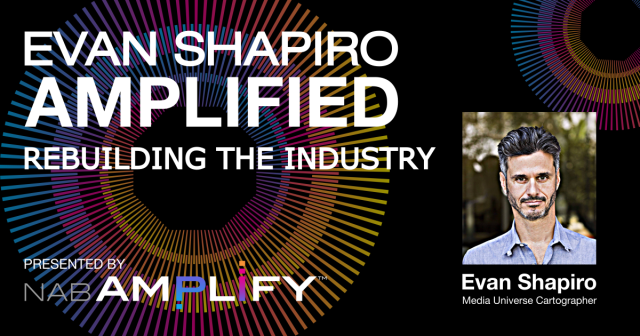TL;DR
- In “Evan Shapiro Amplified: What’s Next,” media’s official Unofficial Cartographer warns that the Media & Entertainment industry is already in a new era, which companies will disregard at their own peril.
- This new user-centric era officially began in 2019 with the launch of Disney+, surpassing Netflix in total worldwide subscribers in just three years.
- Shapiro urges media companies to let go of outdated practices and embrace new strategies that will propel them into the future.
- He points to “The New York Times” as a case study of a traditional media company that has successfully shifted to a user-centric business model.
Data doesn’t lie, and nobody interprets it quite like media universe cartographer Evan Shapiro. In this exclusive Q&A, “Evan Shapiro Amplified: What’s Next?” he sifts through the numbers… and forget about clinging to the past; Shapiro’s new research is about to drag Media & Entertainment into a future it can’t ignore. Watch the full discussion in the video at the top of the page.
The New Media Ecosystem: The User-Centric Era
According to Shapiro, our current user-centric era officially began in 2019. “When Disney+ launched, they got 10 million new subs in one month,” he explains. “In less than three years, they passed Netflix for total worldwide subscribers, and in the process bringing everyone else from traditional media along into this brave — or scary — new world.”
Yet, many media companies are still struggling to adapt. “So we find ourselves in a world where these leaders from past eras… are now scrambling to make up for quickly falling revenues and audiences in traditional media,” he says.
With the media landscape in constant flux, Shapiro’s new map of the 2023 Global Media Ecosystem serves as a navigational tool for understanding these seismic shifts. Scaled by communities and revenue, the map provides a visual guide to changing consumer habits and the choices they face.

One of the most significant shifts has been the rise of big tech companies in the media landscape. Shapiro doesn’t mince words when describing the influence these companies have. “These massive big tech Death Stars and the disproportionate gravity that they have in the ecosystem… enables them to invade the markets of the traditional players in these segments, and take share mindshare revenue share attention share away from the traditional players.”
In this new ecosystem, consumers are not short on choices. When they pick up their devices, they’re greeted with a plethora of options. “Now we’re in a period or an era where the consumer curates their own media bundle on their phones,” Shapiro says.
Media companies can no longer afford to look at their services in isolation. “When you look at where your life’s blood of audience and revenues are coming from, you have to look at these things all in concert of each other. You cannot take them as individual pegs inside a larger ecosystem, you have to see the connectedness now,” he advises.
If you’re still waiting for the user-centric era, you’re behind the curve. “We’re not approaching it. It’s not coming. It’s not on its way. It’s here and it’s been here for some time,” Shapiro emphasizes.
As Shapiro sees it, traditional media companies may soon find themselves part of a larger lifestyle bundle. “That is a big part of the mandate, old-school big media that we’ve known for the last 50 years will be subsumed and become part of larger enterprises that are offering a lifestyle bundle of services that include things like free delivery, or streaming music, or books or gaming, or software, more cloud service,” he predicts.
Case Study: The New York Times
Shapiro points to The New York Times as a prime example of how media companies can not only adapt but thrive in the new user-centric era of media. The NYT’s journey offers valuable insights for any media enterprise looking to navigate today’s complex landscape.
The New York Times doesn’t have 200 million subscribers, yet it’s thriving because it’s super-serving a highly engaged, valuable set of consumers. “It sounds simple, and yet, almost no one’s doing it,” Shapiro notes. He adds, “Scale for scale’s sake is not the quest here, super-serving a very highly engaged, valuable set of consumers across a set of revenue inputs and outputs — that’s the assignment now.”
In the early 2010s, The New York Times found itself in a precarious position. “The New York Times was in a nosedive,” Shapiro recalls. The media giant seemed on the brink of either dissolution or absorption by a larger enterprise. The Times took a bold step by bringing in fresh leadership from outside the American media ecosystem. “They hired the head of the BBC, Mark Thompson, someone who had never run a commercial enterprise before,” he notes.
Thompson’s arrival marked a sea change for the organization. “He took money out of the print newsroom and put it into the digital newsroom,” says Shapiro. The shift from a print and advertising-centric model to a digital subscription focus was radical but necessary. The strategic pivot paid off handsomely. “In 2022, where the rest of digital media was suffering, The New York Times had a surge not just in subscribers, but also in revenues and profits,” Shapiro highlights.
The Times also shook up its internal structure. “They hired a bunch of young, late 20s, early 30s product managers and thought leaders and empowered them to make changes at the enterprise,” he says.
The Times has expanded far beyond traditional news. “They have one of the most important podcasts in the world. They make television for FX and are a very important gaming company,” Shapiro points out.
Despite these changes, the Times has stayed true to its core mission. “Their mission to educate and inform the world remains intact. They did not sell their souls in order to succeed,” he says.
This case study serves as a blueprint for other media companies. “The opportunity is to find new ways to get [these services] in the hands of today’s consumers,” he advises.
The Road Ahead
As we navigate the complexities of the new media ecosystem, Shapiro leaves us with some actionable insights and a sense of optimism for what lies ahead. He emphasizes the importance of recruiting — and listening — to the younger generation within your enterprise.
“Listen to people who perhaps haven’t always been there, who might have better ideas on what’s actually coming because they’re the consumers you’re looking to serve,” he advises. In other words, the Gen Z and Gen Y employees within your organization aren’t just staff; they’re also the consumer base you’re trying to reach.
The media landscape is evolving, and so should your business model. Shapiro encourages media companies to think outside the box: “Think about new ways to generate revenues to keep consumers satisfied, that aren’t necessarily your traditional business model.” This could mean diversifying revenue streams or rethinking your content strategy to better serve your audience’s needs.
This is more than a moment; it’s a movement. The user-centric era is here to stay, and the time for action is now. Don’t get left behind — embrace the future today.
Despite the challenges ahead, Shapiro sees a bright future for the industry. “We can get back to growth, we can get back to relevancy, we can get back to opportunity inside the media ecosystem,” he says. The key is to let go of outdated practices and embrace new strategies that will propel your company into the future.
Stay tuned for the next installment of Evan Shapiro Amplified, where media’s official Unofficial Cartographer will dive into the biggest industry trends we can expect in 2024.



